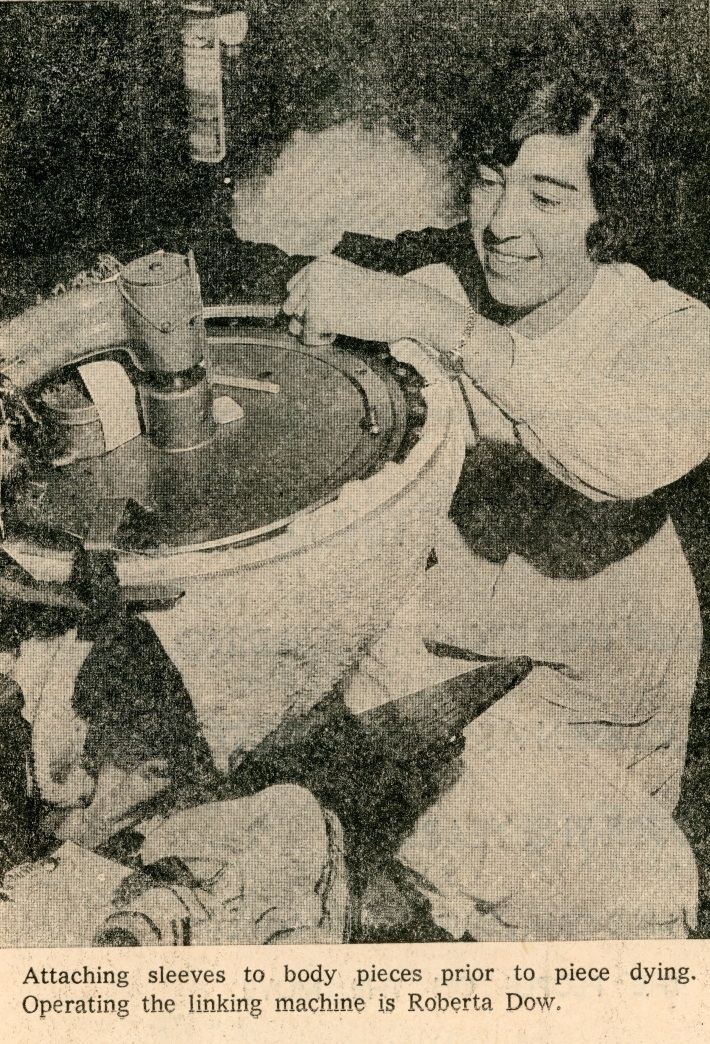On March 22, 1972, the Ashburton Guardian ran a seven page feature to celebrate the opening of the refurbished and extended Tekau factory. This week we are re publishing an excerpt from that feature that helps tell the story of this important business. This is just a tiny snippet from the story of Tekau.
Beginnings
 “The history of Tekau Knitwear Limited dates from 1931, when Mr and Mrs Frank McIntosh commenced the manufacture of knitted garments in their home. The first equipment was a 10-gauge flat bed knitting machine and the word “tekau”, which is Maori for the numeral ten, was adopted as a trade name.
“The history of Tekau Knitwear Limited dates from 1931, when Mr and Mrs Frank McIntosh commenced the manufacture of knitted garments in their home. The first equipment was a 10-gauge flat bed knitting machine and the word “tekau”, which is Maori for the numeral ten, was adopted as a trade name.
A branch factory was opened at Timaru in 1944. This was primarily engaged in the manufacture of cotton interlock fabric for the underwear trade, and secondly for the making up of knitted outerwear from fabric, knitted in Ashburton. The company’s head office was also established at Timaru at this time.
In 1947 substantial additions were made to the Ashburton factory and a considerable amount of new plant was purchased including full fashioned knitting machines. A modern dye house was established and new boilers were installed.
In 1954 the firm of Rutherfords, of Dunedin, was purchased and in the following year this plant and equipment was transferred to the Ashburton and Timaru factories.
In 1956 the Ashburton factory was further extended to house additional full fashioned plant and in 1957 a factory was opened in Christchurch. In 1959 a new warehouse was erected in Ashburton and a contract let for the erection of a 40,000 sq. ft. factory at Theodosia Street, Timaru.
In the same year a course gauge full fashioned knitting machine was installed at Ashburton to increase the diversity of this plant. An additional dyeing plant was also installed to cope with the increasing demand for the company’s products.

Additions
In 1960 extensive additions were made to the Ashburton factory. In the early 1960s a further full fashioned and circular knitting plant was purchased and dyehouse operations extended.
A new yarn store was erected at Ashburton and the new factory building at Timaru was completed in November, 1961.
The world-wide upsurge in demand for double knit fabrics has been the most spectacular advance in the textile industry for many years. Tekau began the manufacture of these fabrics in 1960 and the double knit division at Timaru is now a very important area of the company’s operations.
Tekau today is one of the leaders in the field in the double knit operation in this country.
They produce double knit fabrics in wool, acrylic, wool acrylic mixtures, crimplene textured polyester and wool-polyester mixtures.
The production of one-way stretch frenchelle double knit fabric has been very successful and the company has the sole New Zealand production rights for this fabric. This was achieved through an association with Sydney based French Knit Pty Limited, the inventors of this revolutionary knitting process.

Jet Dyeing
Further plant is being introduced in 1972 and will give additional capacity in finer gauge knits and multi-colour jacquard patterns.
A new jet dyeing machine is being installed at Ashburton and this gives perfection of dyeing in all types of double knits including light weight synthetics.
 Tekau double-knits are marketed through Snow Rainger Limited, the Auckland based textile house whose representatives give expert coverage to the whole of the New Zealand market. The association with Snow Rainger Limited began in 1961.
Tekau double-knits are marketed through Snow Rainger Limited, the Auckland based textile house whose representatives give expert coverage to the whole of the New Zealand market. The association with Snow Rainger Limited began in 1961.
The company began the manufacture of garments from its own double knit jersey fabrics in 1963 and a small proportion of the production from the double knit section is now utilised each season in the production of an exclusive range of women’s dresses, suits and slacks.
Proposition
In 1968 the company began a very extensive programme to extend capacity in the double knit fabric section at Timaru.
In August 1969, the company received a take-over proposition from the Waitaki Farmers’ Freezing Company Limited, and Tekau is now the principal subsidiary in the Waitaki group. The association with Waitaki will ensure that Tekau continues to hold a leading place in the textile industry in New Zealand and further afield.
In the 1969-70 years additional properties were purchased in both Timaru and Ashburton and the Timaru factory was extended to provide additional space for the garment sections. In July, 1970, factories were opened at Rangiora and Oamaru to provide the additional labour requirements necessary to service the increasing demand for the company’s products.

More Machines
Developments in 1971 included the installation of knitting machines for the production of stockingette fabric for the freezing industry and cleaning trade.
The company has had some success in the export field with garments being sold to Australia, Norfolk Island and Asia. A representative is currently showing products in Australia, the Pacific area and USA.
By Ashburton Guardian, 1972
Captions
- Leta Murta and others working at Tekau from the newspaper feature in 1972.
- Roberta Dow.
- New extensions 1972.
- Tekau founder Frank McIntosh second from right with Federation of Labour president, Tom Skinner at right.
- The Tekau finishing room in 1979.

Leave a comment